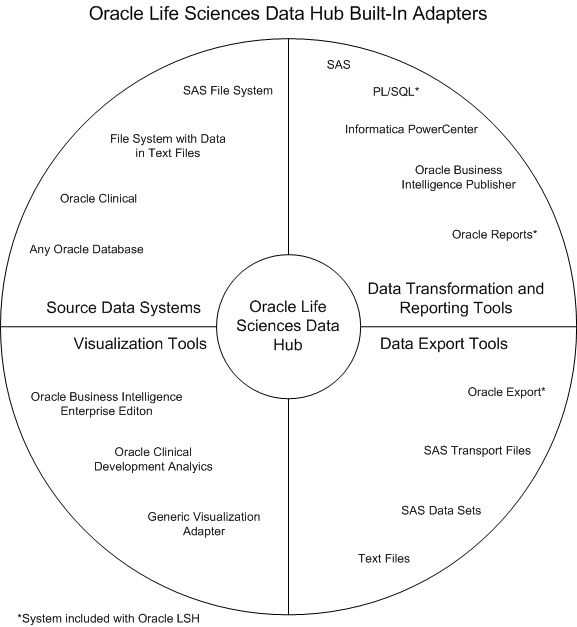| Oracle® Life Sciences Data Hub Installation Guide Release 2.4 E52194-03 |
|
|
PDF · Mobi · ePub |
| Oracle® Life Sciences Data Hub Installation Guide Release 2.4 E52194-03 |
|
|
PDF · Mobi · ePub |
This section contains the following topics:
Figure A-1 shows the logical Oracle LSH architecture that is described in the following sections.
There are two ways to set up a client, depending on the type of user:
Consumers and Administrators Oracle LSH Consumers, who retrieve information in the form of reports and visualizations, and Oracle LSH Administrators, who perform administrative tasks within Oracle LSH, require the following on their personal computers:
A Web browser
Java Virtual Machine (JVM)
Administrators require either JInitiator or JVM to use any of the Oracle Forms screens related to security, to run the post-installation jobs, and to set up user accounts and functional roles.
Definers A full-service client for users who create (define) the programs that operate on Oracle LSH data and generate reports requires additional software:
Oracle LSH plug-in for launching Integrated Development Environments (IDEs)
WinZip
Web browser
In addition, Definers need one or more IDE clients. These may include: SAS PC, SQL*Plus, SQL Developer, Oracle BI Administration Tool, Oracle Reports, Oracle Business Intelligence Publisher, Informatica PowerCenter client.
In addition to standard Oracle Applications components, Oracle LSH's application tier includes the following:
Oracle LSH Application Server The Oracle LSH Application Server renders the user interface using the Oracle Applications Framework and handles the communication between the user interface and the database using the Java Runtime Environment.
Oracle LSH Distributed Processing (DP) Server The Oracle LSH DP Server handles the communication between Oracle LSH and the external processing systems required to support the IDEs.
Processing Systems XML Publisher is required for internal Oracle LSH processing. The other systems are required only if you are developing Oracle LSH Programs in those technologies:
Oracle XML Publisher is used by Oracle LSH to run system reports. Oracle LSH also uses XML Publisher to create Report Sets as a single PDF output with a unified table of contents and custom templates.
Oracle Reports executes user-developed Oracle Reports Programs.
Oracle Business Intelligence Publisher executes user-developed Oracle BIP Programs.
SAS executes user-developed SAS Programs.
Informatica PowerCenter executes user-developed Informatica programs.
The Oracle LSH database tier includes the following:
Oracle Enterprise Edition RDBMS. All of Oracle LSH's database tier components use the Oracle Enterprise Edition database server and database.
Oracle Applications Schema. The Oracle Applications Schema is the schema installed as part of the Oracle Applications installation.
Oracle Workflow. Oracle LSH uses Oracle Workflow to allow users to create and execute Workflow programs. Oracle Workflow is installed with Oracle Applications.
Oracle Warehouse Builder (OWB). Oracle LSH uses the OWB Java Server and schema for running and tracking internal and external jobs.
Oracle Thesaurus Management System (TMS). Oracle LSH uses TMS's database tier internally to run its classification system, which is a required part of Oracle LSH functionality.
Oracle LSH is intended for integration with other systems for a variety of purposes. Each external system integrated with Oracle LSH requires an adapter to handle whatever communication and exchange is required, depending on the purpose of the integration and the technical specifications of the external system. Oracle LSH is shipped with built-in adapters for loading data into Oracle LSH from other systems, for developing and executing programs operating on Oracle LSH data, and for exporting data out of Oracle LSH.
Figure A-2 shows the adapters that are included with Oracle LSH. Adapters to other systems may be available from third parties.
Figure A-2 Oracle LSH Adapters by Functionality

LSH includes adapters to external systems from which you can load data into Oracle LSH:
SAS. The SAS adapter allows you to load SAS data sets into Oracle LSH.
Text. The Text adapter allows you to load text files from any system into Oracle LSH.
Oracle Databases. The general Oracle Databases adapter allows you to load data from any Oracle database into Oracle LSH.
Oracle Clinical. The Oracle Clinical adapter family includes eight specialized adapters for loading the following data and metadata from Oracle Clinical:
Data Extract SAS Views
Data Extract Oracle Views
Global Library
Labs
Study Data
Study Design and Definition
Stable Interface Tables
Randomization
Oracle LSH includes adapters to set up the following systems as integrated development environments (IDEs) for developing and generating programs:
SAS
PL/SQL
Informatica PowerCenter
Oracle Reports
Oracle Business Intelligence Publisher
Oracle LSH includes adapters to allow the following systems to display visualizations of Oracle LSH data:
Oracle Business Intelligence Enterprise Edition (OBIEE) Answers
Oracle Clinical Development Analyticsâto view visualizations in OBIEE Answers of Oracle Clinical data in Oracle LSH
Generic Visualization Adapterâto integrate other visualization tools